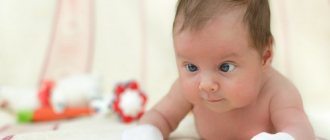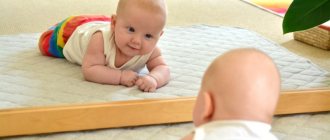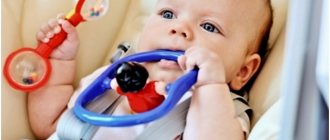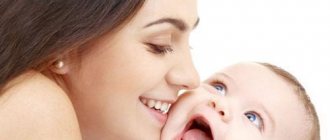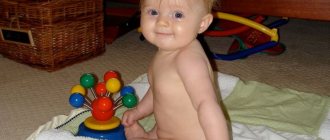When does a newborn begin to see and hear? This question is of great concern to young mothers of first-born babies. When a child settles into his home, the joy of parents and relatives knows no end! What eyes, what hands! Everything pleases in a small creature. But why doesn't he focus his gaze on the object? Isn't it scary? Mommy should know that newborn babies do not see like adults.
Peculiarities of vision in babies
Babies are seen from birth and this is an established fact. It takes time for a baby’s vision to adapt to new conditions. Until this moment comes, the newborn squints, as the bright light causes him discomfort. At the same time, some babies immediately after birth look around at everything around them with wide open eyes. You can see the baby's interest in what is happening.
Closer to 4 months, the baby will begin to distinguish colors, remember the faces of relatives and will be able to fix his gaze on an object that he likes. So that parents are not worried about doubts about the development of their child’s vision, they should show him to an ophthalmologist every six months. After the examination, he will tell you how vision develops and advise the necessary actions to take care of small eyes.
Exercises to help your child sit up
The simplest thing you can do is to regularly place your baby on his stomach for a few minutes.
From the first week to three months of life: lightly stroke the baby’s back, belly, arms and legs. In this case, the stomach and back can be gently stroked up and down and in a circular motion, the arms - from the palms to the shoulders, and the legs - from the feet to the hips. You can also gently knead your toes and hands, this also stimulates the development of speech skills. Often kids love this process and look forward to it.
After three months, we add movements: we cross the baby’s arms, open them, bend and unbend the legs. Curling your legs toward your stomach also helps with intestinal motility. We lift the baby from a lying position to a semi-sitting position by the wrists.
From about four months, the baby can try to sit up, and the exercises can be done for longer.
Ball exercise
. Smooth movements calm and train children's vestibular apparatus. We place the baby on his stomach, gently bend his knees to the sides. We rock the child back and forth and in a circle, holding him by the lower back. This exercise also strengthens the muscles of the neck, back and abdomen.
Exercise "Little Frog"
. The baby is lying on his back. Grab his legs by the shins, covering his knees with your fingers, and make a couple of movements, as if a child is squatting. Spread your bent legs to the sides. Turn the baby over onto his stomach and gently press on the feet with your palms so that the baby bends and spreads his legs on his own. This exercise relieves increased tone in the legs.
"We arch our back"
. Lay your baby on his side. Hold your legs with one hand, and with the other, stroke your back from the lower back to the neck. The child will reflexively arch his back. Then turn over to the other side and repeat.
Exercise "Fingers"
. Place your baby on his back and hold his feet in your palms so that your thumb is at the base of your toes. Press lightly and your fingers will bend. Then move the pad of your thumb from the heel to the little toe, and the child will open his toes.
"We rise and fall"
. Place your baby on his back so that his legs rest against your stomach and carefully place your palms under the back and back of the baby's head. Then slowly lift the baby and lower it just as slowly. This exercise strengthens your abdominal muscles.
Exercise “Crawling on your tummy”
. We lay the baby on his stomach, place the arms under the chest, legs bent and spread apart (M-position). We clasp the baby's shins with our palms and touch the baby's soles with our thumbs. The child straightens his legs and pushes away from your hands.
"Walking"
. We hold the child by the chest under the arms so that the legs touch the surface of the floor, sofa or table. Gently tilt it one way or the other. This is a training based on the support reflex, thanks to which we all learn to walk.
Exercise for the vestibular apparatus
. The baby lies on his back, you fold his arms on his chest, pull his legs to his stomach in the M-position, and support the back of his head and neck with your other hand. We rock the child in a circle and back and forth.
Such exercises can be done almost from the first days and continued even when the child begins to sit independently. This is a daily general strengthening exercise that can be easily performed at home. It should be done no earlier than an hour or an hour and a half after the child has eaten. Choose the duration of classes depending on the availability of time and the baby’s mood. Classes can take from five minutes for a newborn to half an hour for a one-year-old child. Make sure that the activities do not cause discomfort to your baby.
How do newborn babies see?
The baby's acquaintance with a new atmosphere occurs through vision. However, kids see everything completely differently than an adult. Baby vision features include:
- The optimal distance at which babies see best is 25cm. It is this distance from the mother’s face that occurs when feeding a baby. Therefore, he remembers and recognizes his mother’s face faster than other relatives.
- Most of all, children like to look at faces. The baby curiously examines every facial feature of mom, dad and close relatives, trying to remember them.
- Babies up to 3 months cannot distinguish colors; all pictures for them are black and white. Therefore, it is not recommended to hang too bright toys above the bed. For this purpose, you can place a carousel or mobile in the same color scheme above the baby’s crib. Great interest is shown in geometric shapes and patterns in the form of a cage or strip.
- To help the child focus his eyes on one thing and not create a strong load on the small neck, toys above the bed should not be placed above the child himself, but a little to the side or closer to the legs.
- After 3 months, the baby distinguishes between yellow and red colors, this is due to the structure of the organs of vision. The child is not yet able to distinguish other shades. Therefore, you can begin to decorate its habitat with brighter and more colorful objects. When a child looks at colorful toys, his face completely changes, acquiring more adult features. This change has a scientific name - visual memory. It influences the baby’s thought processes, thereby laying the prospects for subsequent personal development.
- It is easier for a baby to focus on a detail if he is in an upright position. Therefore, to show your baby something interesting, you should stand him in a column, holding his head.
- Proper lighting is the key to healthy vision. The baby should not be in a room with dim lighting, as this can negatively affect his vision.
Baby's vision and hearing
Don’t worry - all newborns are born partially deaf and partially blind, because they lived for a long time in a specific environment - the mother’s womb. For intrauterine existence, vision and hearing are not required, which is why these organs did not develop. The adaptation period to the conditions of the new world lasts several months. These are the protective functions of the body: nature protects the little man from unnecessary shocks during the transition from one world to another. It was cozy, warm and dark in my mother’s tummy.
Partial blocking of the organs of vision and hearing protects newborns from stress.
Is the baby really born completely blind? At what age does a baby begin to focus his eyes? In fact, a baby is not born blind or deaf, and after a certain time all the functions of the senses come to the appropriate state. When will the baby start hearing? Clear hearing will appear in due time, you will notice it. Children hear even better than adults (this quality is lost over time).
What do newborn babies see? At first, they only distinguish between light and dark: their vision is unclear and their images are blurry. The little one sees a picture - “a hedgehog in the fog.” What can a baby distinguish well in a month? At this time, the child can already catch a bright large object with his vision if it is nearby. Therefore, bright moving toys with music are hung in the cradle to develop the ability to hear and fixate the gaze.
Favorite objects to observe
The newborn begins to see the world around him very selectively. The baby's favorite pastime is looking at his parents. When a newborn begins to see, the father is of greatest interest to him. Dads have special, pronounced features, which are complemented by a mustache, beard, and glasses. For the first six months, it is advisable not to change the appearance of either mom or dad, so that the baby does not get scared. Any changes can cause whims in the baby.
Other favorite objects for viewing include black and white photographs, as well as patterns in black and white.
Why do babies cross their eyes?
Many parents, noticing that their child is squinting his eyes, become very frightened, thinking that this could develop into real strabismus. However, not everyone knows that squinting eyes is quite normal for babies up to 6 months old.
This condition is associated with weak eye muscles. It is still difficult for a baby to look at objects with both eyes at once and focus his gaze. As a rule, strabismus disappears by 7 months, but if this does not happen, then the child should be shown to a specialist.
Parents can independently check their baby's vision at home. Shine a dim flashlight into the eyes, tracking the reflections. If they are located in the center of the pupil, then there is no reason to panic, otherwise you need to see an ophthalmologist.
When does a newborn begin to hear?
Do you already know when a newborn begins to see, but what about his hearing capabilities? As soon as you pick up the baby from the hospital, study his behavior and observe him. Many health problems in a child can be identified at an early stage thanks to the observation and care of parents. At the same time, you should not panic about every reason, since newborn children are all quite different and all processes in their body develop according to an individual plan.
So when does a newborn start to hear? Doctors have long established the fact that the baby perceives the first sounds in the womb. This process occurs already from 16-17 weeks. That is, there are still 5 months before the baby is born, and he is already receiving information about the world around him. This is why expectant mothers are advised to talk to their baby, even if he is not yet born. A great option is to read good fairy tales to him and turn on pleasant, calm music. The baby, most often, actively reacts to sounds from the outside: he may begin to move when he hears a melody or, on the contrary, calm down when his mother speaks to him.
Features of visual skills
How to make a month-old baby see his mother? To do this, you need to bring your face very close to the baby’s face in order to accurately fall into his field of vision. Don't hesitate, your baby will definitely see you! This is how he learns to recognize his relatives. The mother's face is usually the very first visual image that an infant recognizes in the new world.
Why does the baby look strange, does he really have a squint? Don't worry, a baby under four months does not have the ability to clearly fix his gaze on an object. Understand that in the womb no objects came into his sight. The baby and head begin to hold only at three months, especially with a glance!
How many months should I wait for my eyes to stop running and squinting? Some newborns squint their eyes until they are six months old. This is normal, however, it won't hurt to see an ophthalmologist. A home method for checking strabismus is using a flashlight. You need to shine a flashlight into the eyes (not from close range!) and see where the reflection is. If the reflection of light is in the same place, there is no need to worry. If in one eye the reflection is in the center, and in the other eye it is on the side: you should sound the alarm.
How does the baby react to sound?
Some people tend to think that the baby has trouble hearing in the first few days because there is fluid in his ear. Accordingly, in their opinion, the newborn begins to hear as soon as the fluid leaves the sink. This statement is a kind of myth, because a child must respond to sounds from the first days of life. The baby can also distinguish voices: he clearly hears the differences and over time remembers who owns this or that voice.
It is worth noting that after birth a newborn clearly distinguishes:
- intonation;
- timbre;
- tempo (speed of speech);
- animal sounds;
- sounds of technology;
- rattles
Recognition of sounds is revealed in active movement of arms and legs, in searching for the source of sound with the eyes, freezing and listening, crying, shuddering.
If in the first few days the baby does not respond to sounds, do not panic and draw tragic conclusions.
Does the child dream?
It is also surprising that a newborn can see not only in reality, but also in a dream. Watching your sleeping children, you can see how they move their arms and legs, how their facial expressions change, and sometimes they even cry or laugh in their sleep. All this allows us to answer the question of whether newborn children dream.
What are they dreaming about?
Unfortunately, science has not yet reached the level of development to look into other people's dreams. Growing up, the baby forgets about what he dreamed at such a young age and cannot tell others about it.
In the study of children's dreams, scientists cannot come to a consensus and put forward the most incredible hypotheses. Psychologist David Faulks argues that children under the age of five are not able to dream the way adults do. But, most likely, this opinion is wrong.
We can only assume one thing: the content of the dreams of infants and older children differs from the content of adult dreams. This is explained by the fact that the baby’s consciousness is poorly developed, he cannot speak and does not fully understand the speech of others. Hence the assumption arose that children's dreams consist of colors, sensations, emotions, and also do not contain sound. In addition, the baby is not able to realize where the dream is and where the reality is.
Checking your baby's hearing
If it seems to you that your baby has hearing problems, a few days after his birth, you can quietly pat next to the baby's ears and see his reaction. If a child hears you, he will definitely turn his head in the direction of the sound or blink.
There are cases when hearing impairment in a baby is a consequence of illnesses suffered by the child’s mother during pregnancy. First of all, we are talking about rubella and measles. Also, hearing problems can be caused by bad habits of the mother or the use of toxic drugs.

